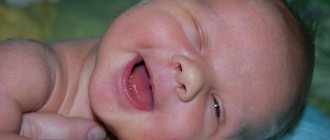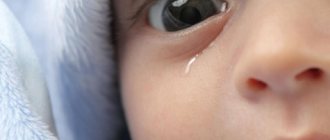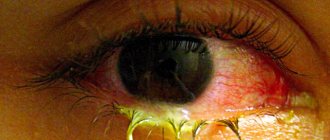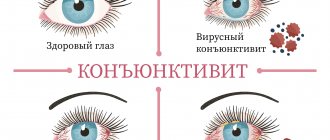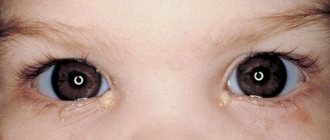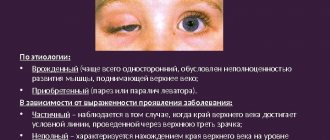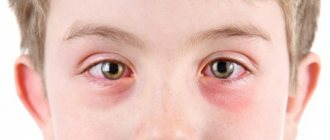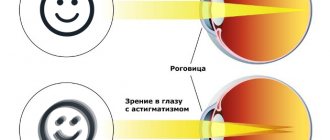Conjunctivitis is a contagious infectious disease that takes its name from the mucous membrane of the eyeball. The conjunctiva is a very sensitive part that covers the outside of the eyeball and resists damage. Thus, the disease conjunctivitis is an inflammatory process of this very membrane and is accompanied by redness of the entire eyelid and unpleasant discharge from the eye.
Features of the baby's visual organs
Despite the fact that newborn babies cry often, they do not produce tear fluid at first.
The thing is that even in a full-term baby, not all organs and systems are fully developed, including the eyes.
A baby who has just recently been born practically cannot see; he needs time so that he can focus his gaze on objects and clearly distinguish them.
The baby's visual organs are fully formed only by the age of six months.
Before birth, the fetus has no need for tears, since it is completely in a moist, protective environment. The ducts through which tear fluid should be released are still blocked with special plugs.
In a newborn at 6-12 weeks, the plugs gradually dissolve and the first tear fluid is released - abundantly or very sparingly.
And although tears have appeared, they do not contain enough antibacterial substances capable of absorbing various pathogenic microorganisms and suppressing their development. In addition, the mechanism for washing away tears during blinking is not yet fully functional, so harmful microbes are not completely removed.
Without good protection, the conjunctiva, the connective membrane of the eyeball, often becomes inflamed in the baby, causing a number of alarming signs. Pediatricians warn that conjunctivitis in infants can provoke complications, so the baby should be shown to a pediatrician and treated according to the prescribed regimen.
Every fifth baby, in the first weeks of life, experiences a blockage (obstruction) of the lacrimal canals - dacryocystitis, causing conjunctivitis. If it is not associated with an infection, then to eliminate the pathology it is enough to do a massage.
Diagnostics
Before establishing the correct diagnosis, it is necessary to consult and examine the child with an ophthalmologist. He conducts special ophthalmological studies, and, if necessary, laboratory tests in order to find out the cause of the disease.
If there are purulent formations, the smear is sent to the laboratory for cytology.
If the reason lies in an allergic reaction, then testing for possible allergens cannot be avoided, and additional consultation with an allergist and immunologist may be required.
We suggest you watch a video in which Dr. Komarovsky talks about conjunctivitis in newborns and its treatment methods
Classification of conjunctivitis in infants
There are several types of disease, which are distinguished based on the cause of occurrence:
- Bacterial (purulent) inflammation. The causative agents of the disease are pathogenic bacteria, of which there may be several:
- Staphylococcal conjunctivitis. Staphylococcus aureus is detected, which is active against the background of disruption of vital organs or purulent-septic pathologies of newborns - omphalitis (inflammation of the navel), pyoderma (inflammatory lesion of the skin), etc.
- Viral conjunctivitis in infants. The disease is provoked by the herpes virus, its symptoms may appear even before the baby is discharged, then treatment is prescribed in the maternity hospital. Viral conjunctivitis in an infant is sluggish and is accompanied by the appearance of a rash on the eyelids. In most cases, only one eye is infected.
- Gonococcal conjunctivitis of infants (gonoblenorrhea). The pathogen can be transmitted from mother to fetus during labor, then the primary signs of the disease appear on days 2-3. Later development of conjunctivitis suggests that infection occurred after birth. Gonoblenorrhea is a dangerous disease that can lead to the death of the eye. Therefore, the Ministry of Health of the Russian Federation issued a law on mandatory preventive measures: a newly born baby wipes its eyes with a swab soaked in a disinfectant and applies 1 drop of a 20% sodium sulfacyl solution to each eye. The procedure is repeated after a few minutes.
- Chlamydial inflammation of the conjunctiva. The causative agent of the disease is chlamydia, an anaerobic microorganism that occupies an intermediate position between bacteria and viruses. With this type of disease, either one or both eyes can be affected. The acute form - with copious purulent discharge, appears in infants 2 weeks of age. Premature babies can vomit as early as 4 days after birth.
- Autoimmune conjunctivitis. It can act as an independent disease or develop against the background of ARVI. Accompanied by severe swelling of the eyelids and conjunctiva and other obvious symptoms.
- Allergic conjunctivitis. In infants, the most common allergens are dust, pollen, contact with fabric, and, less often, food. The course of the pathology is painful.
A quarter of children suffering from allergic conjunctivitis have one or both parents suffering from this disease.
Provoking factors
Despite the peculiarities of the visual organs in infants, and their vulnerability at first, not all babies develop inflammation. What can trigger the development of pathology?
The risks of conjunctival inflammation increase in the following cases:
- if the child has low immunity;
- a woman in labor suffers from an infectious disease that can be transmitted to the baby when passing through the birth canal;
- the expectant mother has genital or oral herpes;
- the baby is not provided with proper hygienic care;
- It is more difficult for premature infants to resist pathogenic pathogens;
- Dirt particles or foreign bodies enter the newborn's eyes.
Most factors can be eliminated if the expectant mother takes care of her health and, after giving birth, takes care of the baby’s hygiene.
How does conjunctivitis manifest in infants?
It is important for parents to identify the disease at the initial stage; in this case, the child can be cured in a short time and complications can be prevented. Symptoms depend on the type of disease.
Viral inflammation of the conjunctiva:
- profuse lacrimation;
- redness of the mucous membrane of the eye;
- Initially, one eye is affected, but later the infection spreads to the second;
- the eyes are covered with a thin whitish film.
Purulent conjunctivitis:
- purulent discharge forms in the eyes;
- after sleep, the baby cannot open his eyes, because the pus causes the eyelids to stick together;
- swelling appears;
- irritation occurs on the mucous membrane;
- hyperemia and increased lacrimation;
- More often the infection affects only one eye.
Allergic conjunctivitis:
- the conjunctiva turns red and swells;
- bothered by burning and itching sensations in the eye area;
- because of the pain, the baby may squint and turn away from the light;
- mucous discharge appears;
- allergies are often accompanied by a cough and runny nose.
Any sign of an inflammatory process in the eyes should alert you; you should definitely consult a pediatrician. If necessary, he may recommend visiting an ophthalmologist.
It is not recommended to treat conjunctivitis in an infant on your own, since different types of the disease require different therapy, and, in addition, you can harm the sensitive organ.
Symptoms
In order to recognize the disease, you need to pay attention to the following symptoms:
- Redness of the eyelids - the lower eyelid becomes bright red; in more rare cases, the upper eyelid is affected.
- Puffiness - the eyelids swell and this creates the effect of stuck eyes.
- Increased lacrimation.
- Severe itching - the baby is capricious and constantly rubs his eyes.
- Purulent discharge - yellow accumulations form in the corners of the eyes, which later, as they dry out, become like crusts and because of this it is difficult for the child to open his eyes in the morning.
Conjunctivitis may also be accompanied by fever, decreased appetite, and general malaise and lethargy.
Treatment of illness in an infant
After examination, the specialist prescribes therapy based on the origin of the pathology, the degree of damage and other related factors.
Therapy for viral inflammation
For diseases caused by adenoviruses or enteroviruses, it is recommended to apply warm lotions to the eyes.
The baby is prescribed complex therapy:
- Interferon drops - used in both eyes and nasal passages;
- antiviral ointments - Oxolinic, Bonafton, Acyclovir;
- drops with antiviral action - Actipol, Trifluridine;
- antiseptic solutions - for treating the affected organ and removing accumulated secretions.
Apply the products to your eyes very carefully, using separate cotton swabs for each.
Therapy for bacterial conjunctivitis
In this case, you cannot do without the use of antibacterial drugs. The baby is prescribed medications that are available in liquid form - a solution or suspension.
Pus should be removed with sterile gauze wipes soaked in chamomile decoction or Furacilin solution.
The process should begin from the outer corners of the eyes, moving towards the inner ones.
The napkin should be changed after each manipulation.
Most often, the drugs Albucid and Levomycetin are prescribed, the dosage and duration of treatment is determined individually . Among the popular remedies is also Oletethrin ointment.
All drugs used should not be cold; the bottles should be warmed in the palms of your hands before use.
Therapy for allergic conjunctivitis
The first thing that is necessary is to identify the allergen and, if possible, eliminate it.
An allergist is involved in the treatment of this pathology, and he decides on the need to prescribe antihistamines.
If we take into account the age of young patients, the range of antihistamines narrows significantly. At an early age, Fenistil or Suprastinex in the form of drops, Suprastin tablets can be prescribed.
Parents should be sure to follow these recommendations. If the disease affects only one eye, both are treated.
As an aid, you can use folk recipes, for example, rinsing the baby’s eyes with boiled water with a few drops of fresh aloe juice or tea leaves.
Early diagnosis and proper treatment make it possible to quickly relieve the baby from unpleasant sensations and possible serious consequences.
Folk remedies
Traditional methods of treatment cannot serve as the basis of therapy, but only be used in conjunction with medications.
- Herbal infusions and teas can be used as remedies . For example, the most commonly used are chamomile and calendula. These herbs have powerful antiseptic properties and quickly clear the eyes of a newborn of accumulated pus. Pharmacies can sell ready-made herbs in bags, which you just need to pour boiling water over and let steep for about 5 minutes. It is important to check the temperature before processing so as not to burn the baby.
- Furacilin for conjunctivitis in newborns is often prescribed by the attending physician. 1 tablet should be crushed to a powder and poured into 100 ml. warm water (not higher than 37 degrees). Seal the container tightly and shake well, leave for an hour until completely dissolved in water. Wet the eyes using a gauze cloth soaked in the solution. After each wash, the gauze should be replaced with a new one. It is important to maintain maximum sterility when preparing this solution.
Many mothers use breast milk, but ophthalmologists categorically prohibit this, since milk serves as a breeding ground for bacteria, and this can further aggravate the current situation.
Possible complications
Infants require special care and attention, since any ailment that is easily curable in adults can cause more serious pathological conditions in an infant.
Conjunctivitis, without timely treatment, can lead to:
- abscess of nearby tissues;
- partial or complete loss of vision.
Preventive measures
So that the baby does not experience all the “beauty” of inflammation of the conjunctiva, parents are required to take care to prevent the disease:
- the baby should be protected from hypothermia and prevent the development of colds;
- keep the house clean, carrying out regular wet cleaning, washing toys and personal hygiene items;
- The baby should be bathed at least 2-3 times a week, washed with boiled water as needed;
- protect the baby from contact with sick guests and family members;
- Take daily walks in the fresh air to strengthen your immune system.
Conjunctivitis is an eye disease that occurs in adults and children at any age. It is important not to self-medicate and entrust therapy to professionals.
Prevention
The choice of drugs in the treatment of newborns is very limited. Therefore, it is better to protect the baby from contact with infection and observe the rules of hygiene as much as possible until the end of the newborn period. It is better to prevent a disease than to treat it.
Women who decide to give birth to a child should be examined for sexually transmitted infections, and if they are detected, treated before the baby is conceived. The birth of children must be planned. It is better to give birth before the age of 25, then the baby will be born healthy.
Jun 11, 2017Anastasia Tabalina
